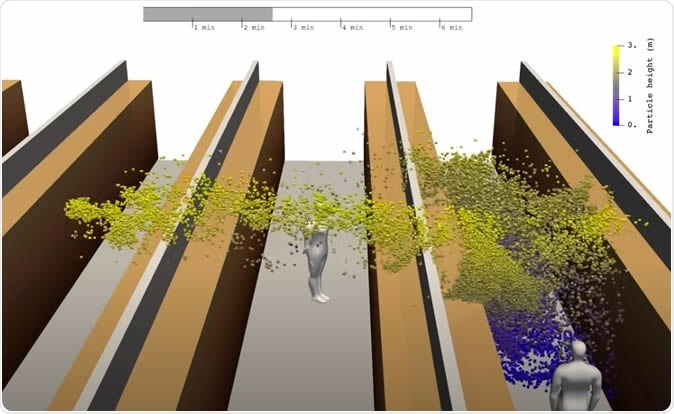In light of the ongoing COVID-19 pandemic, health departments all over the world have been highlighting social distancing, especially avoiding crowded spaces like supermarkets, movie theatres, and offices. A recent study from a group of Finnish researchers reinforces these principles by providing evidence that aerosols from infected persons can spread far and wide, and remain in the air for a long time. This presents a health risk to other individuals in the same space that is higher than previously thought.
The power of respiratory droplet spread
Extensive research has been done on the spread of pathogens like coronavirus through social networks. Clusters of cases are found where a single person has infected several strangers in a public place. These results can be traced back to aerosol clouds, which have the potential to infect a large number of people due to their ability to spread over a considerable distance in a very short time and thus enter the respiratory tract of multiple bystanders.
Epidemiologic modeling studies have also shown that the spread of a virus can be significantly slowed or even stopped by preventing crowding of people at public places like restaurants, malls, and public transport stops.
How was the research carried out?
The Finnish study was based on modeling the spread of aerosol particles from a person coughing in an aisle between shelves, such as one found in a supermarket, with simulated air ventilation. The study shows how pathogenic aerosols can spread over a large distance and remain for a considerable period of time at different heights in the air, thus endangering others even after the infected individual has moved on.

Researchers modeled a situation in which a person coughs down a shelf-restricted corridor typical of grocery stores. Photo: Petteri Peltonen / Aalto University
The research team includes around 30 members from Aalto University, Finnish Meteorological Institute, VTT Technical Research Centre of Finland, and the University of Helsinki. They belong to diverse disciplines, including virology, aerosol physics, fluid dynamics, social networks, ventilation, and biomedical engineering. All three centers are well-versed with the way extremely small airborne particles move out from an individual's lungs during acts like coughing, sneezing, or talking and then carried through the air. These particles could carry microbes like the novel coronavirus.

A new, rapidly put together study on coronavirus and air-borne particles has released first results. The study included researchers from Aalto University, the Finnish Meteorological Institute (FMI), Technical and Innovation Centre VTT and Helsinki University. Crred: Aalto University / Finnish Meteorological Institute / VTT / University of Helsinki: Animation: Mikko Auvinen and Antti Hellsten
The research teams at each center carried out independent simulation modeling with the same starting point. All three models achieved the same initial result - a scenario where the aerosol diffuses in a large cloud and dilutes in the surrounding air. This cloud thus covers a large area around the infected individual. The process takes several minutes, according to Aalto University Assistant Professor Ville Vuorinen, leaving behind "extremely small aerosol particles carrying the coronavirus," which have the potential to infect others in the vicinity for several minutes after the infected person has left the space.
The visualization modeled the movement of particles measuring less than 20 micrometers. This includes droplets emitted by a dry cough, a typical symptom of the current coronavirus, measuring less than 15 micrometers. Earlier studies of influenza A show that this virus may be found in the smallest aerosol particles at 5 micrometers. Studies have shown that such small particles are light enough to float in the same place where they were released or to move along air currents, instead of sinking to the floor. Thus, they remain airborne and a threat to others long after the infected person has left the area.
How do confined spaces contribute to COVID-19 spread?
Many researchers have examined the role of busy indoor spaces in the spread of disease. It is known, from numerous infection models, that when people stop moving around or gathering at nodal points like shops, malls, and public transport centers, viral transmission slows or comes to a stop altogether. In the same way, the current model may help focus more public attention as well as frame appropriate policies on the use of busy indoor places at this time. The presence of many people in a confined space increases the risk of droplet transmission, which is the leading cause of coronavirus spread as far as is currently known.
A 3D model of a person coughing in an indoor environment – how an aerosol cloud travels in the air
Scientific cooperation, satisfying results
The study depended heavily on the ability to simulate how airborne droplets of potentially virus-containing droplets could be carried from the respiratory tract of an infected individual, by a supercomputer made available by the CSC - Finnish IT Centre for Science Ltd. The results were then visualized in 3D. The first results were produced in around a week, primarily due to the computing power and the intense collaboration between the different disciplines.
The research consortium looks forward to refining the modeling to more accurately predict how aerosol particles will behave in social networking areas. The results are expected to be of use to infectious disease and virology experts as they gather more information on the COVID-19 pandemic.
According to Jussi Sane, Chief Specialist, Finnish Institute for Health and Welfare, the modeling itself is insufficient backing to issue new recommendations. However, the results reinforce the guidelines prescribed by the Institute, advising sick people to stay at home, as well as maintaining a physical distance from everyone, coughing into a sleeve or tissue, and washing or sanitizing hands frequently. "These results are an important part of the whole, and they should be compared with the data from real-life epidemic studies,' Sane adds.